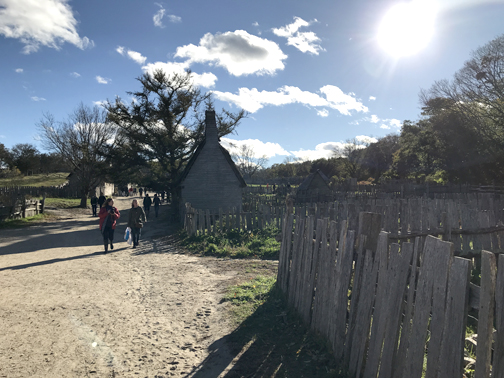
The small English colony nestled on the shore of Cape Cod is a full working village.
By Charly SHELTON
Thanksgiving is a national holiday, speaking to everyone in America as a founding piece of their national heritage, like the Fourth of July. This is a day that celebrates being together, sharing and being thankful. The story told in elementary school is that the Pilgrims had a good harvest and invited their Wampanoag (pronounced WAM-pa-nog) Native American friends to share a feast of thankfulness. And while the reality is a little more complicated than that, the nugget of truth in the center is the feast and giving thanks for having more than is needed.
The first winter in America was tough for the settlers, who we call The Pilgrims. These Englishmen, who had probably never left their cozy homes in Britain before winding up in Cape Cod, Massachusetts in November 1620, were just trying to survive. Their European crops wouldn’t take to the American soil and they had little livestock to rely on. They met the Wampanoag tribe, which lived close by, and through trade and cooperation, the Native Americans taught the settlers how to farm local crops, like squash and corn, how to collect local wild edibles, like the craneberry, and how to find local game, like deer and turkeys. Their partnership ensured the settlers’ survival.

It’s hard to grasp the difficulty of life in those times. I’ve read books about 17th century life in the colonies and had the facts of what was done and why, but it still didn’t impact me the way a visit to Plimoth Plantation in Plymouth, Massachusetts did.
This historical re-creation town started as just one house in 1947 and has grown to a full working village with re-enactors of those who lived in the 1620s. From their speech patterns to making their straw bed each day to cooking clams and boiling pompion (pumpkin), they give visitors of all ages an authentic first-hand experience of what life was like in the young colonies. Having visited there, and walking around the side of the Cape in November, I can attest it was cold, despite having the luxury of North Face jackets. The settlers were wearing simple cotton fabric and furs, with no insulation in their houses and little to eat. They must have been very grateful for the help that the Wampanoag neighbors provided, including getting a hot meal and shoring up their homes as best they could. This brings a new level of understanding to the thankfulness relating to the holiday.
With the successful harvest in 1621, thanks to the Wampanoag instruction, the settlers celebrated their harvest festival the same way they had done in England – thanking God for the their bounty, playing music, dancing, participating in games of skill and eating the all-important feast.
One of their games of skill included rifle marksmanship competitions that, to the unaware Wampanoag nearby, sounded like a show of force and military prowess. Before long, roughly 90 fully armed Wampanoag warriors showed up at the settlement expecting a fight. What they found was a huge feast and party. Each side, realizing their mistakes, chalked it up to a misunderstanding and the settlers invited the warriors to join them for the meal. And though the harvest was plentiful, with 90 more mouths to feed the food ran short, so the tribe brought in five deer, some shellfish and other various foods of the season. The first Thanksgiving in America was co-hosted by the settlers and the Wampanoag in celebration of their productive friendship.
The Plimoth Plantation shows lifeways of the 17th century colonists in a great, immersive way and includes the lifeways of the other settlement in the area. Next door to the small English settlement is the homesite of a Wampanoag family. Members of the modern Wampanoag tribe are living the traditional lifeways, but they do not role play like the English villagers do. Instead, they practice the traditional arts, cooking and lifeways of the 17th century. However, they answer questions from a 21st century perspective. Guests can ask all types of questions without fear of offending because the Wampanoag family is there to specifically educate and foster understanding between modern Native American and European settler descendants. It is one of the best Native American interpretive experiences I have ever encountered, and it really rounds out the picture of life in 17th century Massachusetts.
While relations between the settlers and the Wampanoag deteriorated with the forcible expansion of white colonists into the rest of the country, this first Thanksgiving is still looked upon as representative of the ideals of what all should strive for – togetherness, thankfulness and celebrating having more than is needed when we work together.
The Plimoth Plantation experience brings this period of time to life with re-enactors and modern interpreters without being insufferably annoying like so many other living history museums. As we approach the 400th anniversary of the landing at Plymouth Rock, the Mayflower II – a re-creation of the original ship – has been moved to another bay for cleaning and refitting, and will sail back into Cape Cod to land near the rock in November 2020. Though this is a little way off, it’s not a bad idea to start planning a trip now. This will be a once-in-a-lifetime event and, for those who travel to see it, Plimoth Plantation is a must-see attraction.
For more info, visit Plimoth.org.

